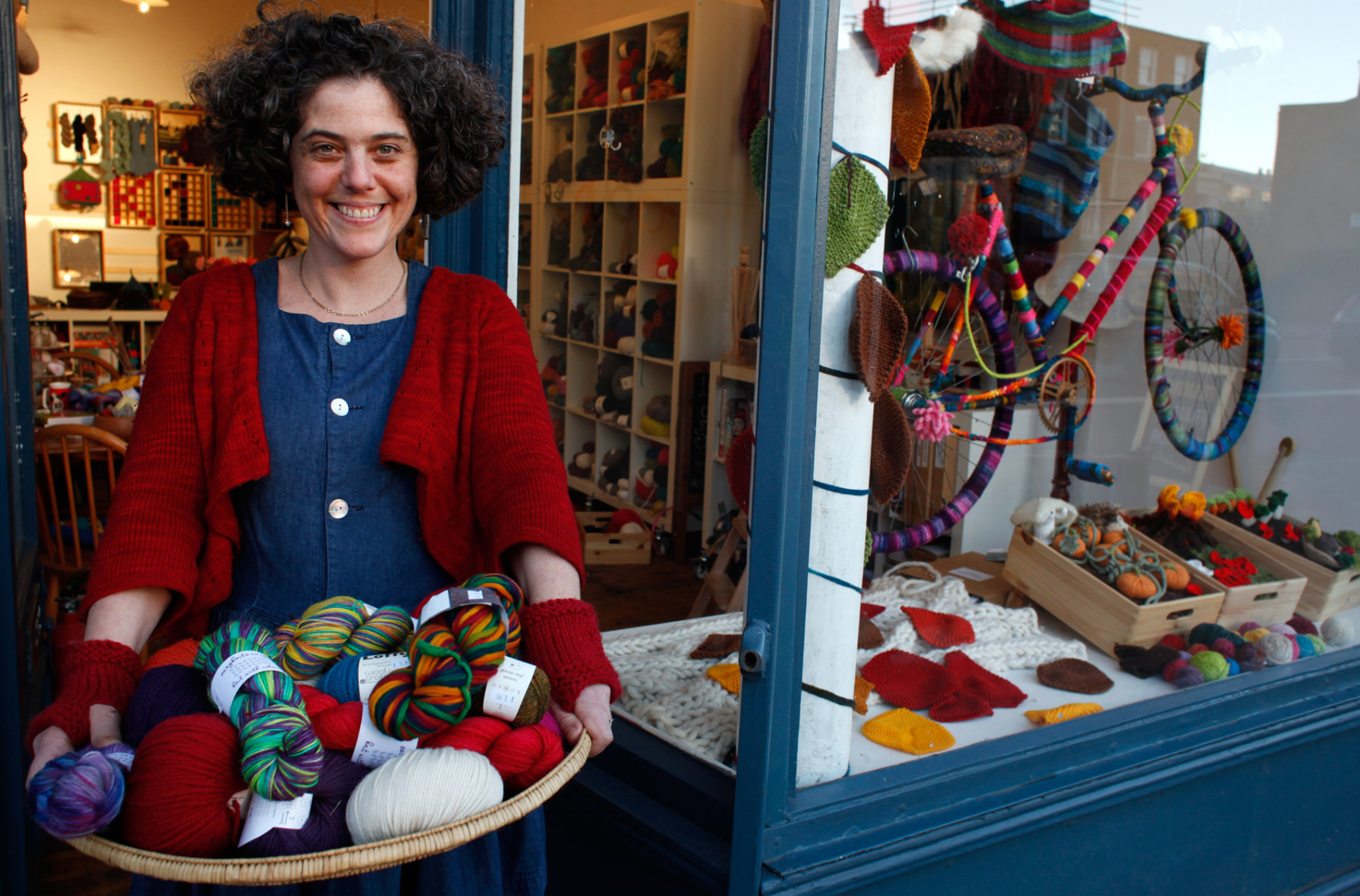“It was when I’d finished knitting the viruses. I started working on a death mask and I looked at it and thought, No. It’s got to be a vulture.“
Harry’s vulture, named Vern, has been stopping passers-by in their tracks, ever since he took up residence in the shop window a couple of weeks ago. Standing about a meter tall, Harry made his legs, body, neck and head using a combination of knitting, crochet and embroidery, from salvaged scraps of yarn: cast-offs from knitters, charity shops and even the odd east London yarn shop.
Thinking about it later on, I realised that there wasn’t really a single piece of the knitted viruses-death mask-vulture chain of events she’d explained which I was particularly clear about. But in the moment of her saying it, she made it seem like the most obvious thing in the world. She manifestly needed to knit and crochet that vulture. I’m even tempted to turn it around and say, Vern plainly needed Harry to make him. I made a mental note to go back and ask her about the knitted viruses later on. For now though, I wanted to focus on Vern.

Harriott ‘Harry’ Knuckles is a textiles artist from Walthamstow in east London and she’s come to the shop to tell me more about Vern’s origin story.
“Growing up I watched vultures in Westerns. My step dad used to like watching Westerns on the telly. When I saw the vultures, I’d think, Oh my God! The vultures are there – what are they going to do!?!“
But Harry goes on to explain that this menacing image of greedy, predatory birds that we’ve all grown up with, is not only unfair. It’s also wrong. In fact, she tells me, “The Navajo Indians understood the vultures as protectors.”
It’s true that vultures feed on the bodies of dead animals (including humans if they are left in an accessible spot), but crucially, only animals which are already dead. So far from being predatory, their ecological eat-everything-except-the-bones behaviour helps to prevent the spread of disease and to recycle nutrients back into the soil. This is down to their astonishing digestive system, which has stomach acid, strong enough to survive eating meat contaminated with anything from tuburculosis and rabies to anthrax and arsenic.
“I started at the nose“, Harry says. I worked on it while I was caring for my mum. Once I knew it was going to end as a vulture, it just developed. I kept adding bits. I’d just do a bit of the wing without bothering too much about the size of it. Oh and I loved doing the feet. I really wanted the feet to be big. I looked at lots of vultures, and there was one vulture that I really liked. It was huge. He had folds of skin, a mad body and a big neck.“
As Harry talks I have this sense of her gradually layering Vern with life and personality. He didn’t come from a grand plan, or even an original intention to create him. His existence is in spite of the absence of all those things. But exist he certainly does, for Vern is now so brimming with character that his demeanour and mood can change – almost mona-lisa-like – without him even flexing a muscle. I am reminded of the morning we spent ‘erecting’ him in the window – by connecting lengths of fishing twine between metal rings on the top of his head and torso, to the cieling. A little more slack or a touch more tension immediately altered Vern’s stance from one of an imposing General to a melancholic loner. As I listen to Harry, it’s clear, that what life there is in Vern, is all down to her genius stitchy brain that he emerged from.
I have to admit that I had my doubts when we first spoke about putting him on display. Afterall, a vulture in the window of a wool shop – could that ever make sense? Will people wonder (in a bad way) what goes on in there? Or worse still, will it scare them away? There’s lots to say about his enigmatic wry smile, but there’s no denying that there is also some darkness in Vern.
I managed with Wikipedia’s help, to solve the making-sense question. The more I informed myself about vultures, their behaviour and biology, the better I understood that their scavenging made them an ideal role model for knitters aspiring to greater sustainability. We all need to be better at using what’s left behind. In fact our Stash Depot of unwanted wool could have Vern as its mascot!
As for scaring people away, Vern has had the exact opposite affect – especially amongst kids who are prone to drag their too-busy parents back to take a bit longer to look at Vern, to notice all the details and sometimes have a chat with him.
And that darkness that undeniably lurks in the stitches of his great beaked head, in the folds of skin on his neck, in the grip of his claws on the branch? Yes, you’re right, Vern is not lovely. Neither is he adorable. There is nothing hygge about his habitat. His feathers and finery come from a bounty of waste and woolly detritus which is as grotesque as it is marvellous. I watch the folk who stop to look at Vern, I listen to their awe struck comments and I know that taking time out from the knitter’s high-cute diet isn’t doing anyone any harm at all.
I never did get to the bottom of the knitted viruses but if Vern has taught me anything, it’s not to underestimate the power of Harry’s stitches to make perfect and obvious sense even when you least expect it.
With grateful thanks to Harriott Knuckles, whose work will be on display in the shop window for the next few weeks.

